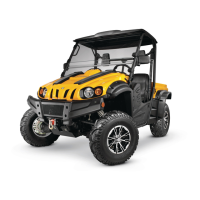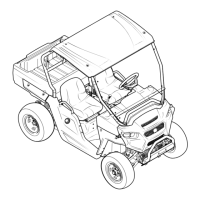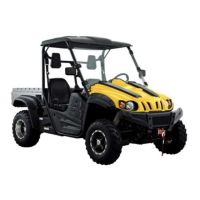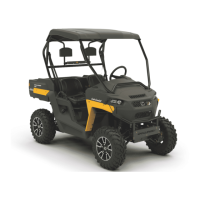Periodic Maintenance
ADJUSTING THE SHOCK
ABSORBERS
There are three adjustment points
on the shocks. The rebound (a),
pre-load spring (b) and damping
rate (c) can be adjusted.
Rebound Adjuster (a)
The rebound adjuster is located near the
bottom of the shock and controls the
“bounce back” speed of the utility
vehicle. To adjust the rebound or
“bounce-back” speed, follow the steps
below:
Note: Each position has a stop or “click”
to indicate the setting.
1. Insert a standard screw driver into the
adjustment.
2. Rotate the screw into one of the 18
positions between “S” (position 0) and
“F” (18). Rotate the screw clockwise
(towards the “S” or “0” position) to slow
the rebound and counter-clockwise
(towards the “F” or “18” position) to
speed up the rebound.
Pre-Load Spring Adjuster (b)
The pre-load adjuster is located in the
body of the shock and controls the
height of the vehicle. It can be adjusted
to accommodate for different load
situations.
Note: This adjustment requires a
spanner wrench to complete. A spanner
wrench is included in the tool kit shipped
with this utility vehicle.
1. Using a spanner wrench, loosen the
upper lock nut.
2. Adjust the pre-load adjuster nut to the
desired setting. Turn the pre-load
adjuster clockwise to increase the
compression force (raise the utility
vehicle) and turn the pre-load adjuster
nut counter-clockwise to decrease the
compression force (lower the utility
vehicle).
Damping Rate Adjuster (c)
The compression adjuster is located on
the upper part of the shock and controls
the ride of the utility vehicle and the
impact resistance of the shocks.
Note: Each position has a stop or “click”
to indicate which of the 18 positions it is
in.
1. To increase the stiffness of the suspension
and increase the absorption of impacts, rotate the
compression adjuster screw clockwise towards
the “SLOW” (or “0”) position.
2. To decrease the stiffness (soften the ride)
rotate the compression adjuster screw
counter-clockwise towards the “FAST” (or
“18”) position.
To return the utility vehicle to its stock
setting, use the chart below:
* -- These setting are based on a “full load”
condition. 250 lb (113 kg) driver, 250 lb
(113 kg) passenger and 500 lb (227 kg)
cargo load.

